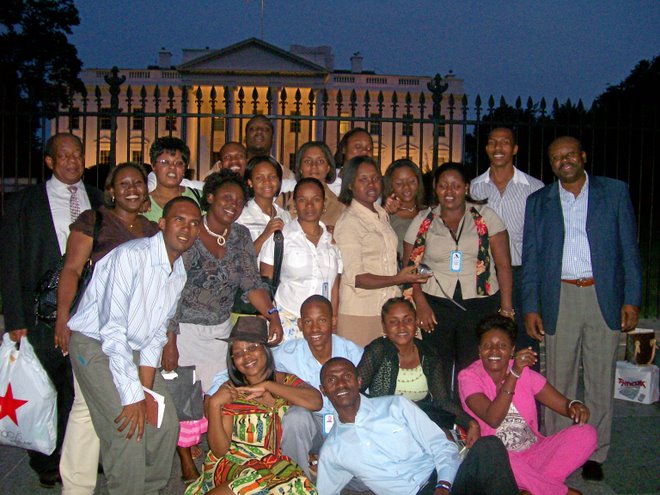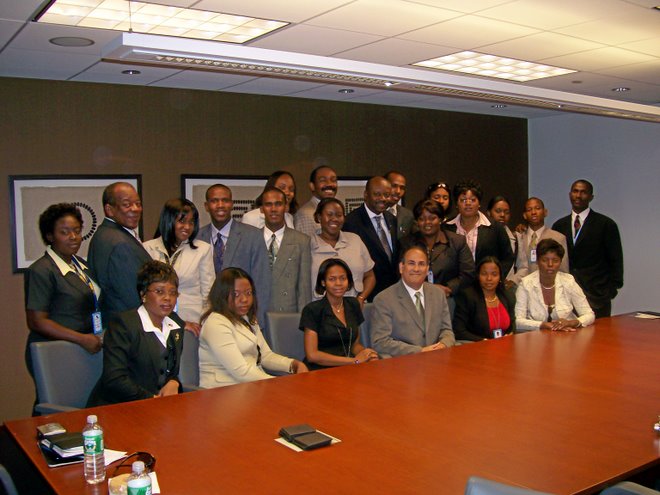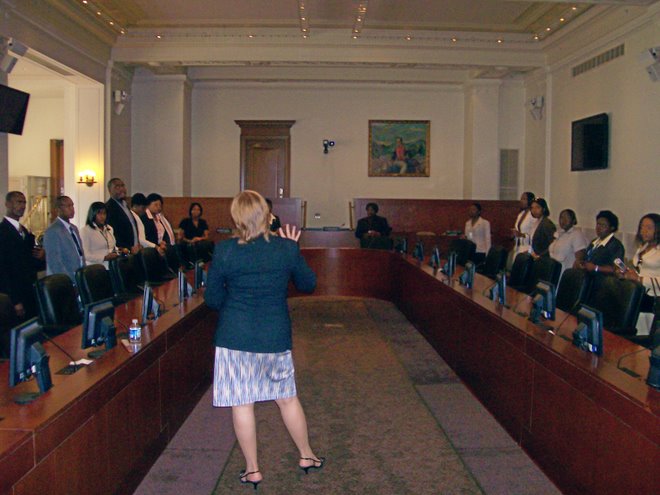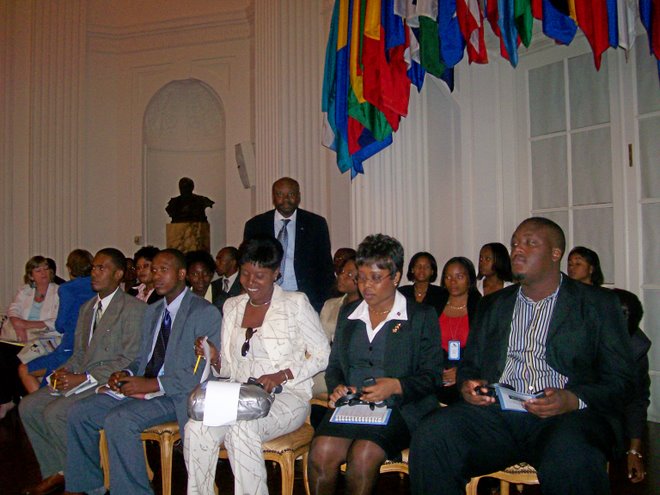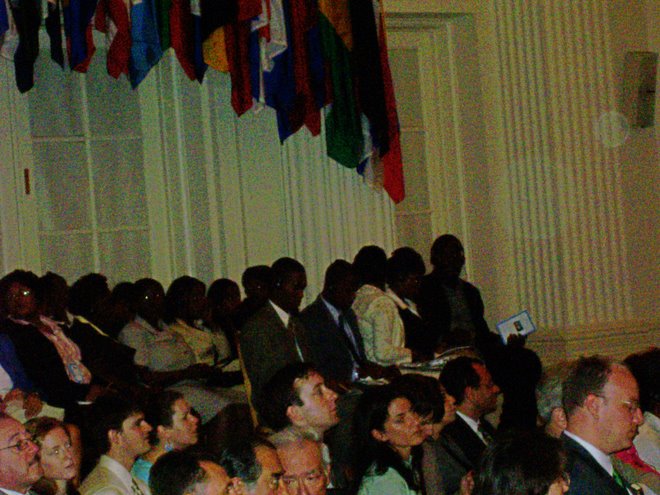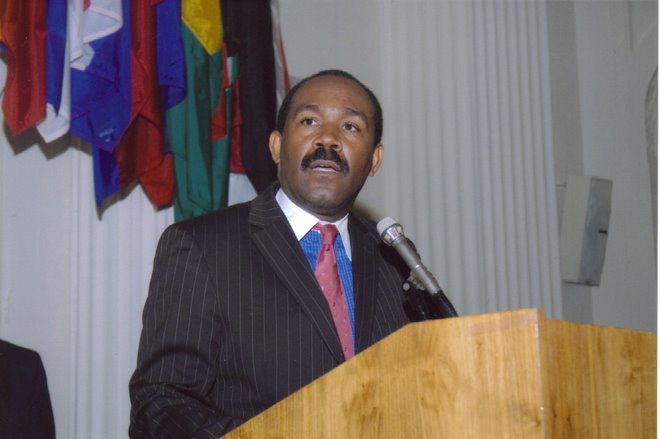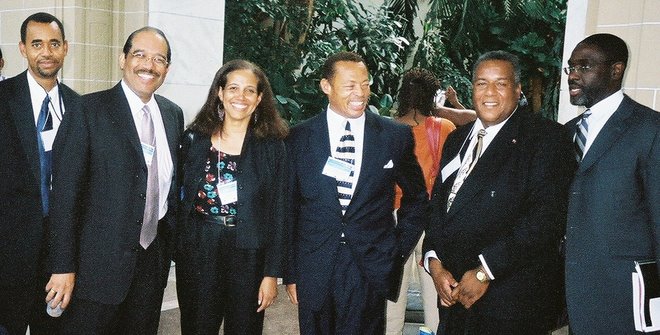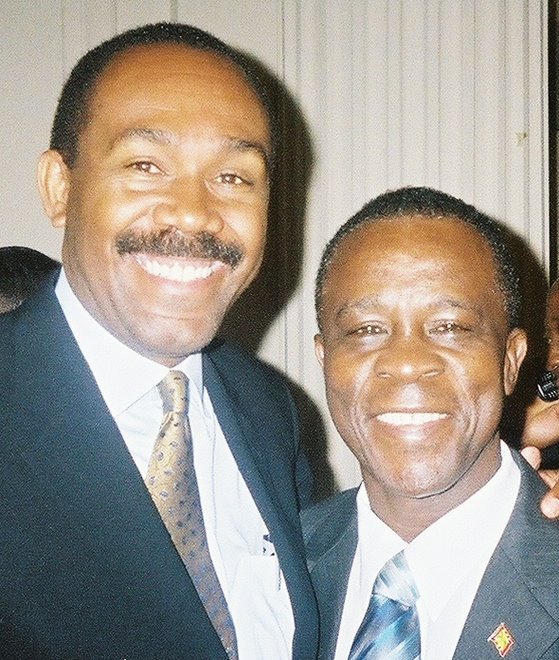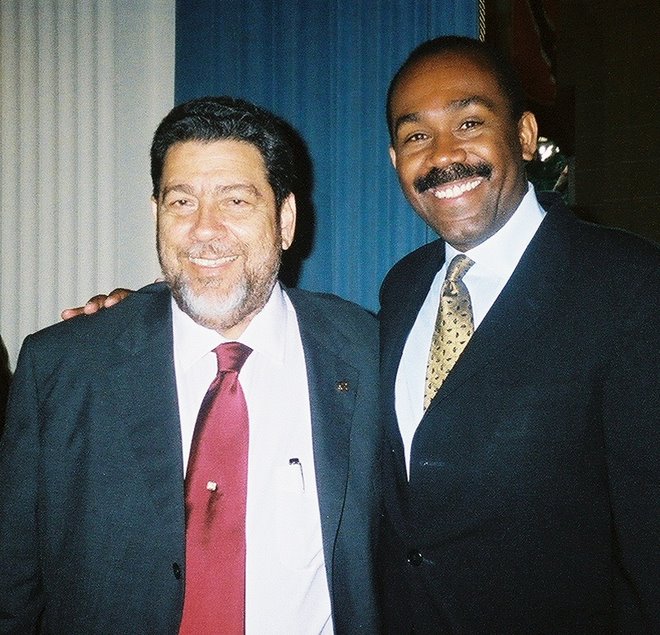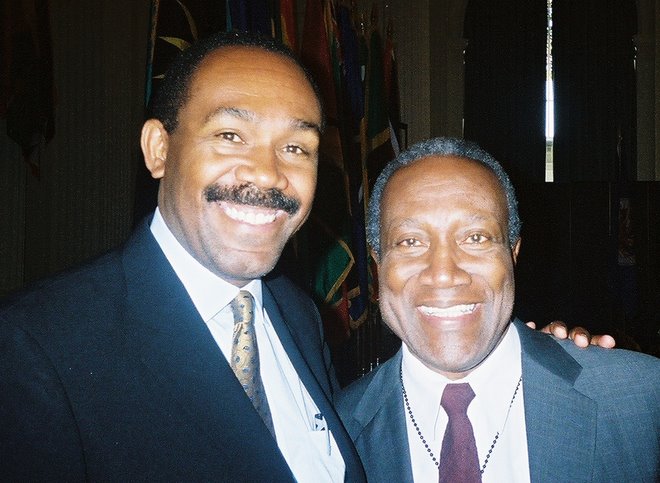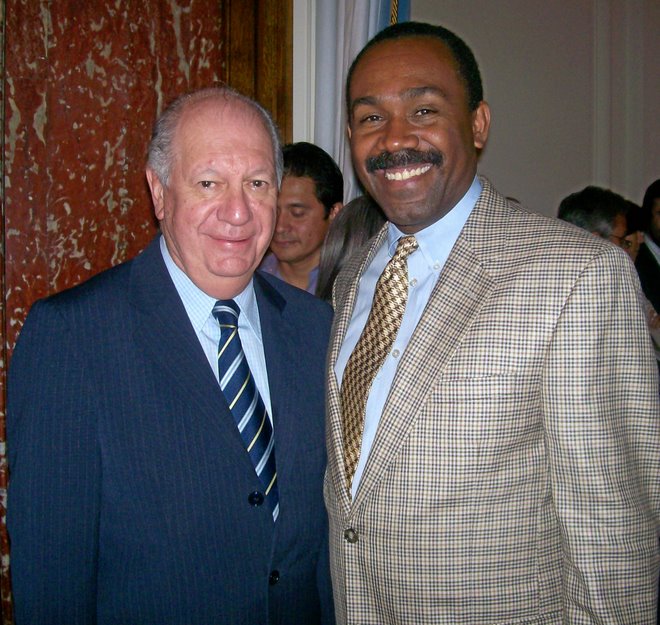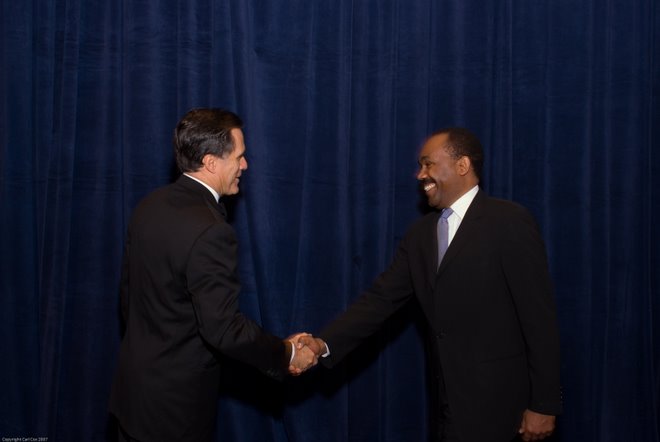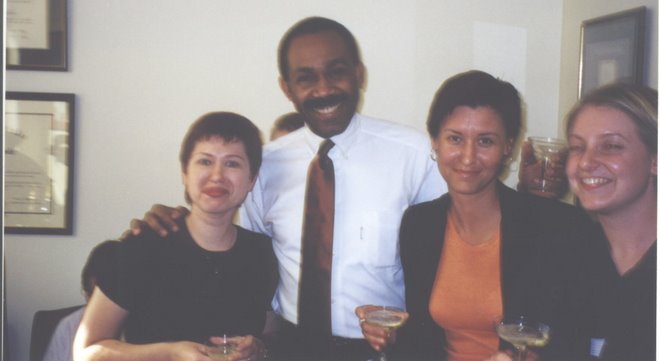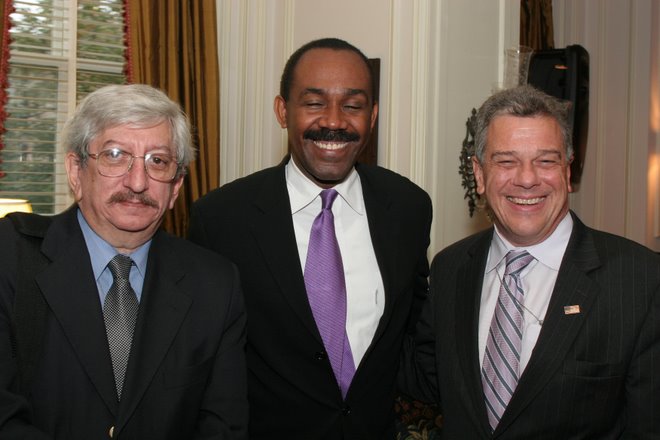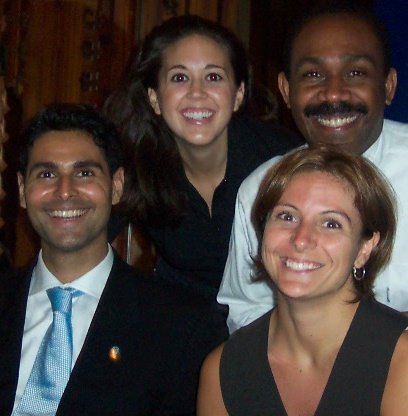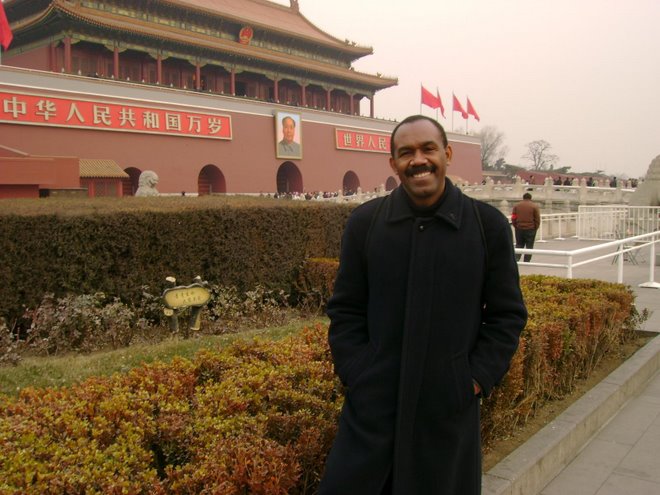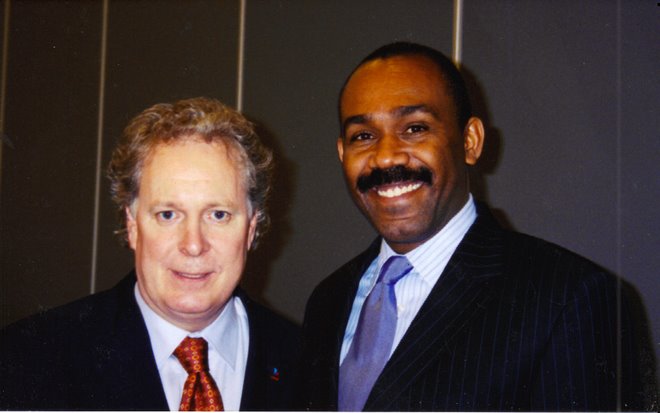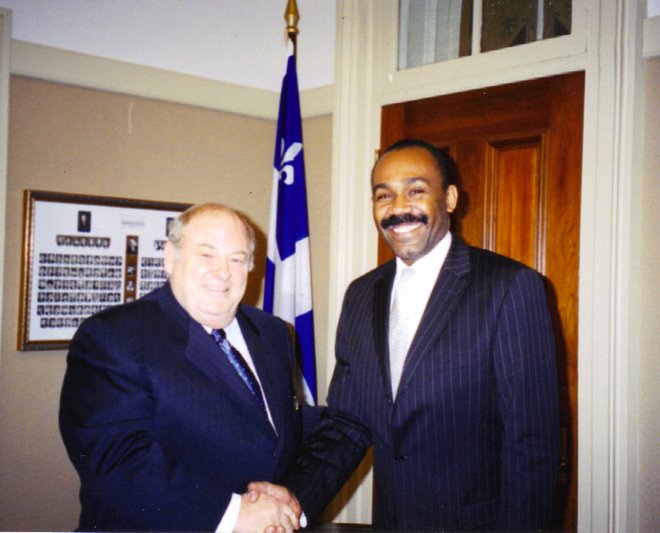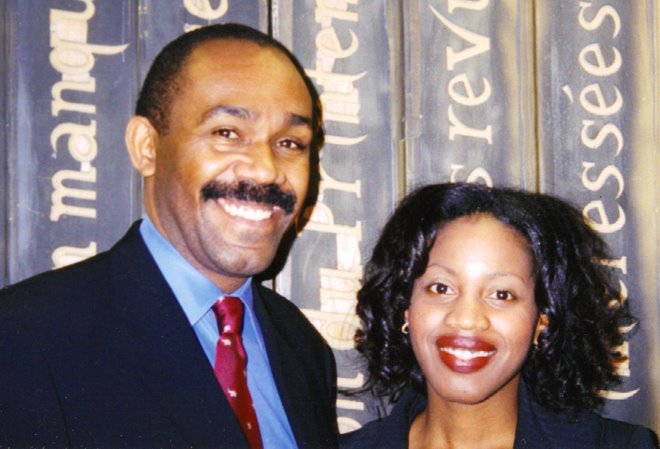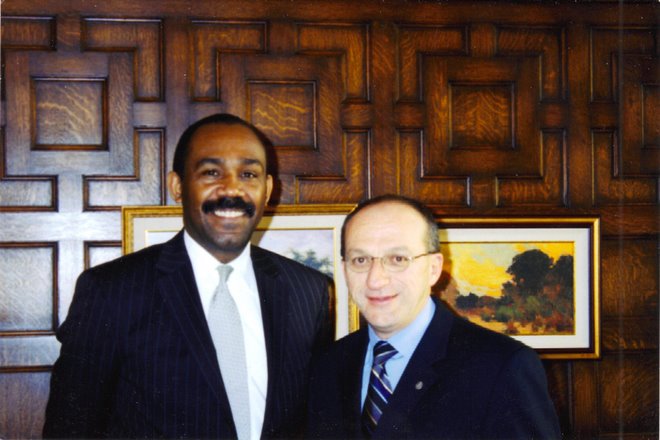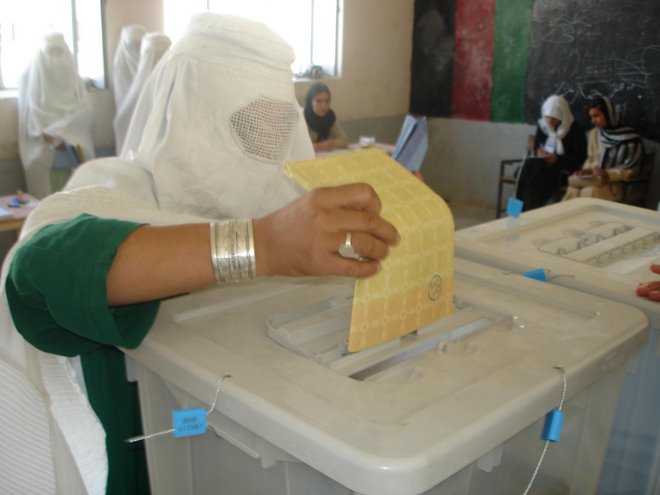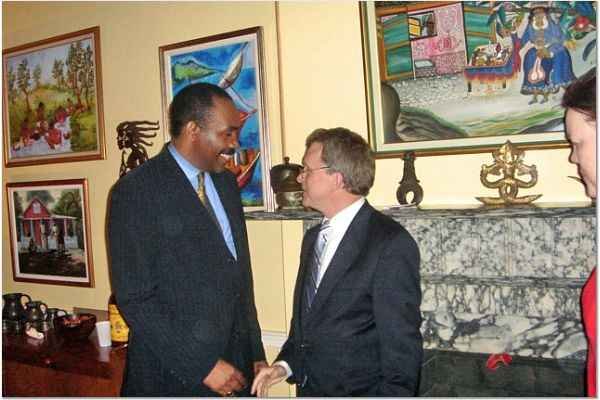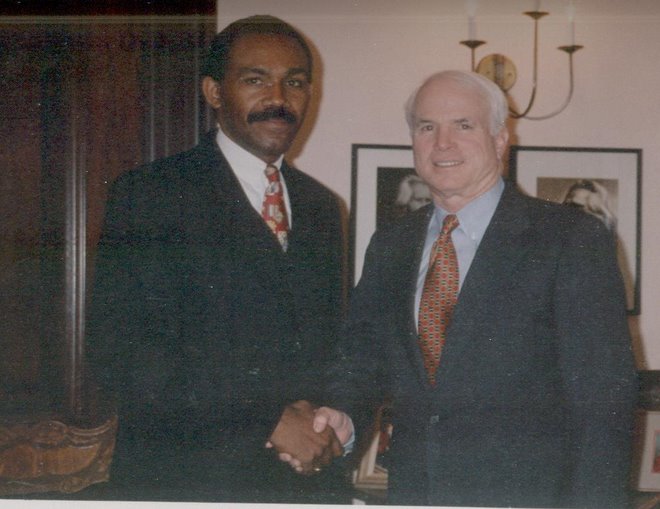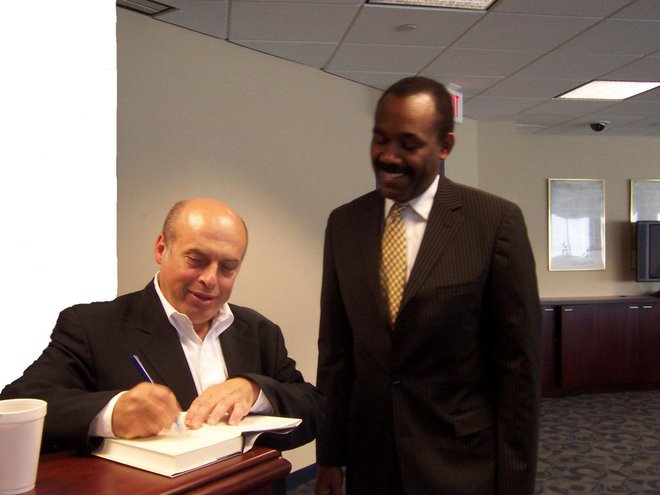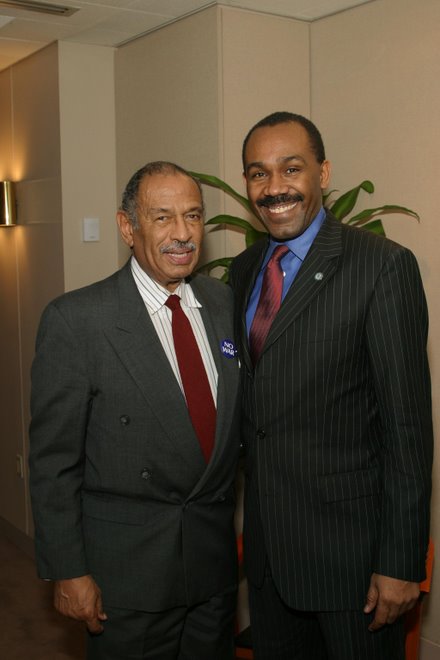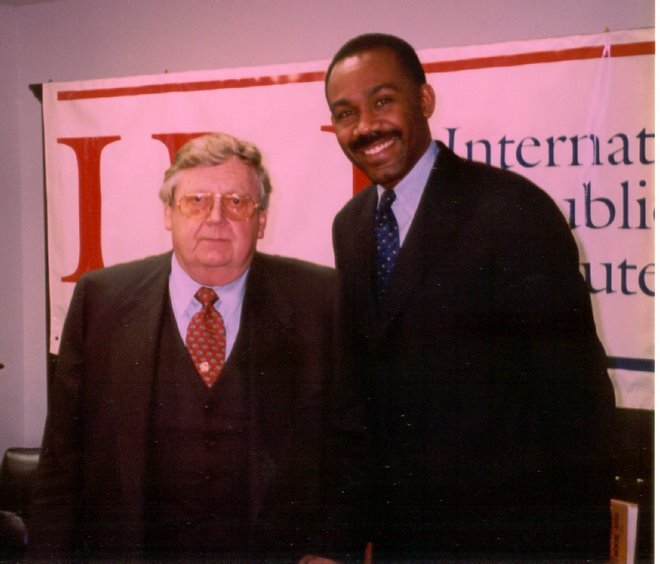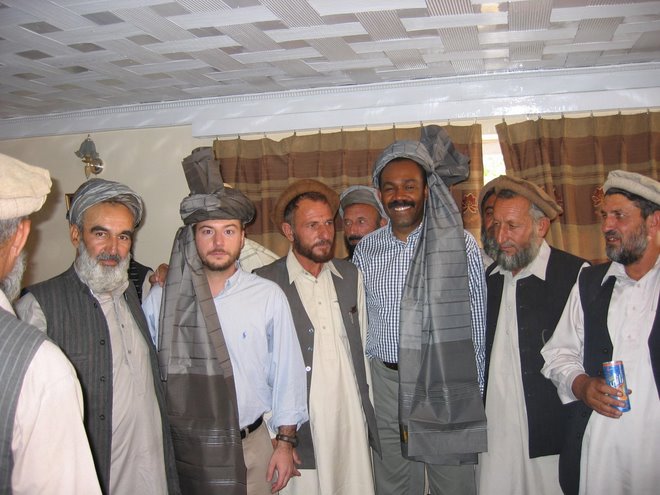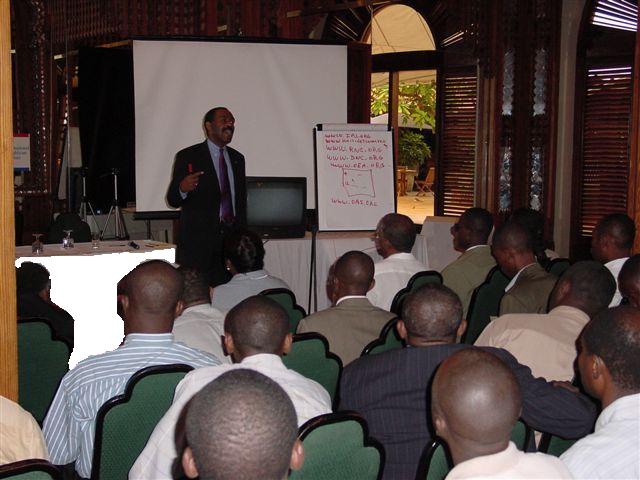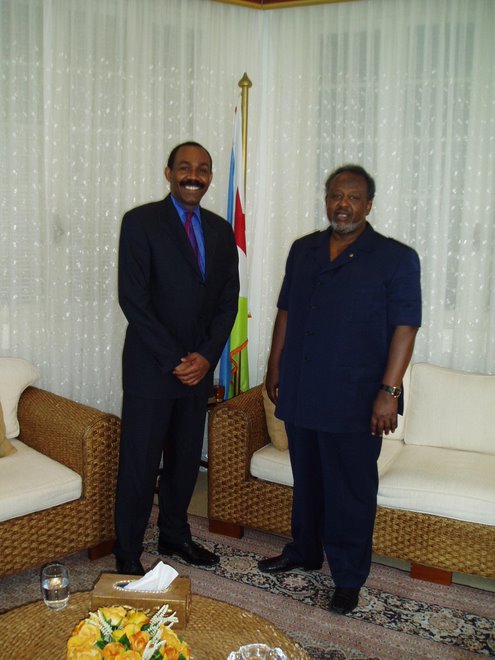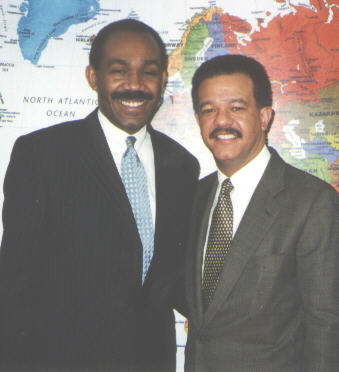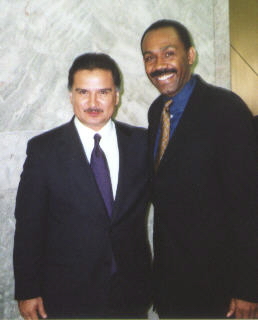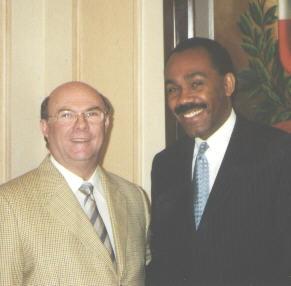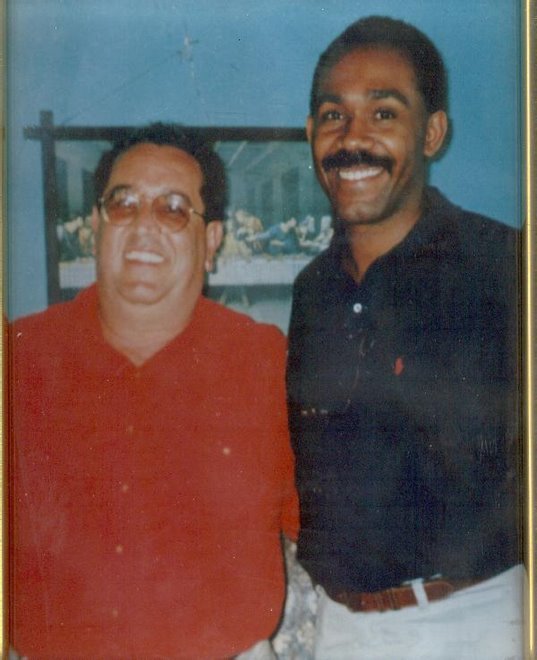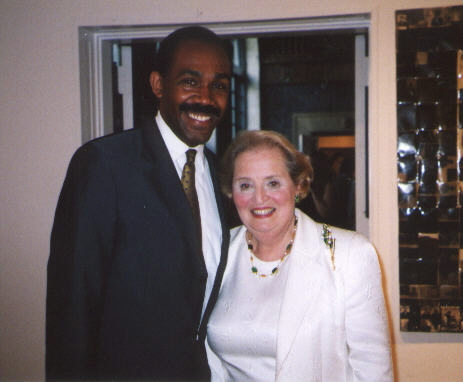Country Reports on Human Rights Practices - 2006Released by the Bureau of Democracy, Human Rights, and LaborMarch 6, 2007
http://www.state.gov/g/drl/rls/hrrpt/2006/78895.htm
Haiti is a republic with a constitution that calls for an elected president and a bicameral legislature. Its population is approximately 8.4 million. After then president Jean Bertrand Aristide resigned and departed the country in February 2004, Boniface Alexandre, chief justice of the Supreme Court, assumed office as interim president (pursuant to the constitutionally prescribed order of succession). In March 2004 Gerard Latortue was installed as prime minister of the Interim Government of Haiti (IGOH). Presidential and run-off parliamentary elections were held on February 7 and April 21. More than 3.5 million citizens registered to vote (79 percent of eligible voters according to a 2003 census), and an estimated 63 percent of registered voters participated in the elections. After a relatively stable and peaceful election process, voters selected a new president and filled 129 parliamentary seats. President Rene Preval and the new parliament took office on May 14.
The UN Stabilization Mission in Haiti (MINUSTAH), deploying 6,668 troops and 1,692 civilian police from 45 countries, provided security in advance of and during the elections, trained and supported the national police force, and assisted the government in suppressing gang-related violence and deterring potentially violent opposition by well-armed and militant political groups.
Despite some improvements, the government's human rights record remained poor. The following human rights problems were reported: occasional extrajudicial killings by elements of the Haitian National Police (HNP); overcrowding and poor sanitation in prisons; occasional arbitrary arrests; prolonged pretrial detention; an inefficient judiciary subject to significant influence by the executive and legislative branches; severe corruption in all branches of government; ineffective enforcement of trade union organizing rights; ineffective measures to prevent violence and societal discrimination against women; child abuse, internal trafficking of children, and child domestic labor; and ineffective measure to address killings by members of gangs and other armed groups; and kidnapping, torture and cruel treatment by gang members and criminals.-------------------------------------
RESPECT FOR HUMAN RIGHTS----------------------
Section 1 Respect for the Integrity of the Person, Including Freedom From:
a. Arbitrary or Unlawful Deprivation of Life -------------------
In contrast with 2005, the government or its agents did not commit any politically motivated killings. However, there were incidents where suspected elements of the HNP (acting outside of their authority) unlawfully killed citizens. The government was, for the most part, unable to conduct thorough and reliable investigations to determine who was at fault. It remained difficult to identify and prosecute suspected killings by HNP officers, sometimes due to imposters posing as HNP officers. The HNP lacked rudimentary expertise and resources and as a result was unable to conduct thorough and reliable investigations of many of these incidents. If suspects were arrested, they were often released due to the country's corrupt and inefficient judicial system.
On May 14, there were two suspected but unconfirmed deaths in prison caused by prison guards using excessive force during a riot at the men's penitentiary. The HNP, prison authorities, and MINUSTAH were unable to substantiate the deaths (see section 1.c.).
In August, media reported that an HNP officer in Gonaives shot and killed a man who was apparently arguing with the officer in front of the police station. The officer was arrested. No additional information was available.
There were some developments in multiple killings by HNP officers reported in 2005 and earlier. Four of the eight HNP officers charged with the 2004 torture and killing of five juveniles escaped from prison in February 2005. On August 30, the criminal court fined the remaining four officers and sentenced them to five years' imprisonment.
At year's end only two of the 15 HNP officers arrested for the August 2005 killings of six men during a soccer match in Port-au-Prince remained in prison and awaited trial. A judge, thought to be corrupt by one human rights organization, released the other 13 officers. Details concerning the release were not publicly available.
Much of the violence in the country stemmed from the activities of organized criminal gangs. Common criminality and armed attacks against civilians continued to create fear among the population.
On July 7, gang members deliberately killed at least 20 residents in the Gran Ravine district of Martissant, a slum area in Port-au-Prince. Many more people were injured and hundreds of homes were burned. The violence resulted from a territorial dispute between rival gangs. Subsequent turf battles in the Martissant area caused several more deaths in the weeks that followed.
On September 21, unknown assailants shot and killed Bruner Esterne, a human rights activist in the Gran Ravine district of Martissant. Esterne was an eyewitness to the HNP killings that occurred at a soccer match in Martissant in September 2005.
On September 26, gang members killed eight residents of Martissant's Fontamara district. MINUSTAH subsequently strengthened its presence in the area, but violence continued.
Suspected retribution killings also occurred. On September 14, Guy Francois, a former colonel in the now-disbanded army, was shot and killed by persons who were talking with him as he sat in his car in Petionville (a suburb of Port-au-Prince). The police have made no arrests in that case.
In response to ongoing violence perpetrated with impunity by criminals, citizens in some neighborhoods resorted to vigilante justice. There were occasional and credible reports of irate citizens in Port-au-Prince killing individuals who were suspected of rape, murder, or kidnapping.
On December 20, a crowd of several hundred citizens confronted HNP and MINUSTAH at an HNP substation under the mistaken belief that the HNP was holding a suspected kidnapper. The mob demanded that the authorities release the suspect so that the mob could kill him. The mob barricaded streets and burned a UN vehicle. HNP and UN-established civilian police (UNCIVPOL) broke up the mob, but at least two of the demonstrators were injured by gunfire and another possibly died. No further investigations were conducted at year's end.------------
b. Disappearance----------------------------------------
Unlike in 2005, there were no reports of politically motivated disappearances caused by government agents; however, there were reports of disappearances that stemmed from internal conflict.
There were widespread kidnappings of citizens from all social strata by armed and organized criminal elements. While most cases were resolved through the payment of ransom, some victims were tortured, raped, and killed while in their kidnappers' custody. There were 554 reported kidnapping victims during the year, compared with 760 in 2005. Many kidnappings were not reported.
In August and September the criminal court convicted and sentenced each of two HNP officers to seven years' imprisonment in two kidnapping cases.--------------------------
c. Torture and Other Cruel, Inhuman, or Degrading Treatment or Punishment-------------------------------------------
The law prohibits such practices and, unlike in 2005 there were no reports that government officials employed them; however, criminal gangs frequently employed these practices.
In September the criminal court sentenced James Montas, an HNP officer, to six years in prison for the rape of Carline Seide on November 2, 2003.
During the year MINUSTAH investigated five cases of sexual exploitation and abuse of minors by MINUSTAH security forces. All remained pending at year's end.
Prison and Detention Center Conditions
All but four of the police stations and prisons damaged or destroyed in 2004 have reopened; however, prisons remained overcrowded, poorly maintained, and unsanitary. According to the NGO National Human Rights Network for Haiti (RNDDH), prisoners and detainees continued to suffer from a lack of basic hygiene, malnutrition, poor quality health care, and the presence of rodents. Furthermore, most prisons lacked adequate food and sanitation and periodically suffered from lack of water, especially in the provinces. The incidence of preventable diseases such as beriberi, AIDS, and tuberculosis decreased during the year but remained a serious issue. Prisons were also plagued by guard corruption. There were 12 known retribution killings of prison guards outside prison walls within the last three years.
On May 14, a riot erupted at the National Penitentiary (housing adult men). Approximately 300 prisoners took over the maximum security facility within the penitentiary and held out for approximately four hours before surrendering to a combined force of prison guards, HNP crowd control CIMO officers (Haitian National Police's Company for Maintaining Order), and UNCIVPOL officers. Approximately 40 prisoners were injured (a few seriously) and perhaps two died according to UNCIVPOL officers on the scene; although the deaths have not been verified by the HNP, MINUSTAH or human rights organizations. Six police officers were injured. Information from MINUSTAH and witnesses at the scene indicated that during the riot prison guards physically abused prisoners, beating non aggressive prisoners with clubs and shooting firearms directly at unarmed prisoners. Intervention by a team of UNCIVPOL and HNP CIMO officers prevented the situation from becoming much worse.
There are separate penitentiaries for adult men and women in Port-au-Prince. The men's facility held 2,235 adult men, and the women's facility held 198 women (both adults and girls). There were 15 other local detention centers throughout the country. In those centers, space permitting, male and female prisoners were held in separate cells. Children 16 and older were confined with adults.
Most boys (109 of 154) were held in a separate facility in Port-au-Prince. By law, that facility may only hold boys ages 13 to 15, although there were a few children who claimed to be 11-to-12 and 16-to-17 years-of-age. Most girls under age 16 (27 of 33) were held in the same cells as female adults in the women's penitentiary in Port-au-Prince.
The government possessed a computerized national system for tracking the movements and status of prisoners in each of its facilities. This system was developed with the assistance of the UN Development Program and was maintained by correctional staff. The total prison population, including both pretrial detainees and sentenced prisoners in the country's 17 prisons, was 4,663. Of the 4,663 prisoners in custody, only 738 of them (16 percent) had been tried and sentenced, while 3,925 detainees (84 percent) still awaited trial.
An already burdened prison system was stressed further with insufficient facilities to hold prisoners, especially as new arrests mounted during the year. Due to lack of available space, minors and adults sometimes were held in the same cell. In addition, overcrowding prevented the constitutionally mandated separation of violent from nonviolent prisoners or convicted individuals from individuals in preventive detention. Many convicted prisoners were incarcerated for long terms in temporary holding cells, particularly in the provinces. Most severely overcrowded was the National Penitentiary in Port-au-Prince, built in 1915. The penitentiary was originally designed to hold a maximum of 800 prisoners and was expanded in 1997 to accommodate an additional 400 inmates, for a total of 1200 prisoners. It held 2,235 inmates at year's end.
The total prison population did not include the large number of persons who were held in police stations around the country in "preventive detention" (without a hearing or charges being filed) for longer than the constitutionally mandated 48-hour maximum detention period. Inadequate record keeping and data entry at the police stations made it difficult to estimate the number of persons held in preventive detention.
The authorities freely permitted the International Committee of the Red Cross (ICRC), the Haitian Red Cross, and human rights groups to enter prisons and police stations, monitor conditions, and assist prisoners and detainees with medical care, food, and legal aid. The ICRC and RNDDH monitored prison conditions in cooperation with the Department of Prison Administration (DAP).
The ICRC's primary concerns related to adequate water, food, and sanitation; however, the government continued to lack the resources to implement necessary changes. -----------
d. Arbitrary Arrest or Detention---------------------------------------
The law prohibits arbitrary arrest and detention, and the constitution stipulates that a person may be arrested only if apprehended during the commission of a crime, or on the basis of a written order by a legally competent official such as a justice of the peace or magistrate. The authorities must bring the detainee before a judge within 48 hours of arrest. In practice officials frequently ignored these provisions. With so many detainees being held in preventive detention without the benefit of a hearing and in violation of the 48-hour rule, it was difficult to determine how many of them were arbitrarily arrested or detained.------------------------------
Role of the Police and Security Apparatus------------------------------------
The 7,700-member HNP has the sole responsibility for law enforcement and maintenance of order in the country. The HNP is an officially autonomous civilian institution under a director general who controls the force. The Ministry of Justice, through its minister and the secretary of state for public security, provides oversight.
In July 2005 the IGOH installed new HNP leadership, which then initiated a program to eliminate corrupt officers, train the remaining officers (including human rights training), and induct new classes of recruits who were cleared by MINUSTAH and UNCIVPOL. The director general installed in July 2005 purged the upper ranks of the internal affairs unit of corrupt officers and appointed a new professional inspector in charge of investigating accusations of police corruption and human rights abuses. Under the director general's leadership, the HNP conducted at times swift investigations of human rights cases and arrested suspected officers.
Reform and professionalization of the HNP continued as international programs provided: training (including human rights training) and equipment for new recruits and for existing officers, police station upgrades, security and humanitarian improvements to prisons, vehicles, computers and communications equipment, forensics equipment and training, weapons inventory and ballistics testing, and technical assistance. Nevertheless, efforts to reform the HNP remained incomplete, and HNP officers were still implicated in corruption, kidnapping, and narcotics trafficking.
The UNCIVPOL element of MINUSTAH supplemented the police and improved the HNP's capacity to maintain order. UNCIVPOL provided training (including human rights training) and operational support. Notably, with UNCIVPOL's assistance, HNP developed relatively well-trained and professional SWAT and CIMO forces.
In many cases the HNP failed to prevent or respond to societal violence, usually gang-related; the reasons being an insufficient number of officers and inadequate training. However, with the assistance of UNCIVPOL and international donors, the capacity and effectiveness of the HNP in preventing and responding to such violence improved.-----------------------------
Arrest and Detention-------------------------------------------
Police sometimes apprehended persons without warrants or on warrants not issued by a duly authorized official. The authorities occasionally detained individuals on unspecified charges or pending investigation.
Police frequently disregarded the legal requirement to present detainees before a judge within 48 hours (see section 1.d.), often because of the sluggishness of the judicial system. Consequently, many detainees were held for extended periods in preventive detention without being informed of charges against them. Prolonged preventive detention remained a serious problem (see section 1.c.).
Bail was available at the discretion of the investigative judge. Bail hearings were not automatic, and judges usually granted bail only for minor cases and based on compelling humanitarian grounds such as a need for medical attention. Detainees generally were allowed access to family members and a lawyer of their own choosing. Many detainees could not afford the services of an attorney, and the government did not provide free counsel.
Prisoners were sometimes detained after they were acquitted. According to information from the National Center for State Courts, an inefficient judicial record system occasionally caused detainees to remain in prison for weeks or months after a court had ordered their release.
Citizens deported to the country after completing prison sentences in foreign countries were often detained, although they had not violated any domestic laws. These detentions sometimes lasted several months. The government justified the practice because of the high level of insecurity in Port-au-Prince, considering those deportees with a record of violent or serious crime as potential threats to the public order. In September a court ruled that such detentions were not valid under the law; however, authorities continued to temporarily incarcerate deportees previously convicted of violent crimes. The International Organization for Migration (IOM) implemented a program to help the government reintegrate the deportees into society.-----
e. Denial of Fair Public Trial------------------------------------------------
Although the law provides for an independent judiciary, in practice the judiciary was subject to significant influence by the executive and legislative branches. Years of extensive corruption and governmental neglect left the poorly organized and poorly funded judicial system largely moribund. Judges assigned to politically sensitive cases complained about interference from the executive branch. There were widespread and credible reports of judicial corruption. Previous attempts by the IGOH to rectify problems within the judicial system were only minimally effective. The newly elected government's efforts to reform the judiciary and judicial systems included the appointment of a new chief investigating magistrate (prosecutor) for the judicial district containing Port-au-Prince.
Systemic problems--including a shortage of funding and adequately trained and qualified justices of the peace, judges, and prosecutors--created a huge backlog of criminal cases, with many detainees waiting months for a court date (see section 1.d.).
Another systemic problem in the judicial system created a barrier for crime victims. After a citizen reported his or her victimization by a crime, justices of the peace charged inconsistent "fees" to initiate a criminal prosecution. These fees varied across jurisdictions and justices. The fees effectively barred some citizens from full access to the judicial system enabled corruption.
Judges increasingly conducted legal proceedings exclusively in Creole rather than French (spoken by only a minority of citizens). However, since some proceedings were conducted in French, language remained a barrier to full access to the judicial system.
In most regions judges lacked basic resources and professional competence. An internationally funded program provided training for judges, prosecutors, and other court personnel, furnished technical assistance in drafting rules and procedures, and worked with the parliament to draft legislation to establish a judicial council that would oversee the court system. In addition, the UNDP provided training for judges and court personnel in Jacmel, Cap Haitien, and Fort Liberte. ------------------------------------------------------
Trial Procedures----------------------------------------------------
The judicial apparatus follows a civil law system based on the Napoleonic Code. Although the constitution provides for the right to a fair public trial, this right was widely abridged in practice. The constitution also expressly denies police and judicial authorities the right to interrogate suspects unless legal counsel or a representative of the suspect's choice is present or they waive this right. Most accused persons could not afford legal counsel for interrogation or trial, and the law does not require that the government provide legal representation. However, some defendants had access to counsel during trials. While the constitution provides defendants with a presumption of innocence, the right to be present at trial, the right to confront witnesses against them, and the right to present witnesses and evidence on their own behalf, in practice corrupt and ill-trained judges frequently denied defendants these rights.
At the lowest level of the justice system, justices of the peace issue warrants, adjudicate minor infractions, mediate cases, take depositions, and refer cases to prosecutors or higher judicial officials. Investigating magistrates and public prosecutors cooperate in the development of more serious cases, which are tried by the judges of the first instance courts. Thirty appeals court judges hear cases referred from the first instance courts, and the 11-member Court of Cassation, the country's highest court, addresses questions of procedure and constitutionality.
The Code of Criminal Procedure does not assign clear responsibility for investigating crimes, dividing the authority among police, justices of the peace, prosecutors, and investigative magistrates. Examining magistrates often received files that were empty or missing police reports. Autopsies were rarely conducted, and autopsy reports seldom were issued. The law provides for at least two criminal court sessions (assises) per year in each of the 15 first-instance jurisdictions for all major crimes requiring a jury trial, with each session generally lasting two weeks. However, this did not occur in practice. Criminal assises in Port au Prince, the largest jurisdiction, have met only once a year since 1998, which was a significant reason for the lengthy delays for prisoners who were awaiting trial.
In addition, each annual assise processes only about 10 jury trials. Since most of the 2,144 detainees awaiting trial in the National Penitentiary were held for serious crimes that warranted a jury trial, they were effectively denied the right to a jury trial. International donor programs allowed the government to conduct additional jury and non-jury trials during the year but did not significantly reduce the backlog.-----------------------------------------------
Political Prisoners and Detainees----------------------------------------
There were differing reports regarding whether the government was holding political prisoners. At least two respected local human rights organizations reported that the government did not hold political prisoners. On the other hand, Amnesty International stated that the government held approximately 100 political prisoners. The differing reports reflected the large number of prisoners being detained without a trial. Since most prison detainees (84 percent) were awaiting trial, it was possible that some of them were being held for political reasons.
Former high-profile detainees, considered by many to be political prisoners, who were released during the year included:
On June 15 and July 27, respectively, former minister of interior Joclerme Privert and former prime minister Yvon Neptune were released from prison after more than two years in detention. Both were charged with involvement in the 2004 massacre of Aristide opponents near St. Marc. Neptune was released for medical reasons and Privert released pending the outcome of his appeal. Although many of the 28 former Aristide government officials and Lavalas supporters who were charged in the killings were provisionally released pending trial, four remained in detention.
On January 29, Father Gerard Jean-Juste, a Catholic priest and pro-Aristide activist who was arrested in July 2005, was provisionally released from custody for medical reasons after he was diagnosed with leukemia.
On August 14, Annette Auguste "So Anne," a self-proclaimed pro-Lavalas community organizer, was released after charges against her were dropped. She was arrested in May 2004 and charged with being the architect of an attack on state university students and faculty in 2003. On August 14 the court also released the other Lavalas militants accused in the attack, including George Honore, Paul Raymond, and Yvon "ZapZap" Antoine, citing a lack of evidence against them.-----------------------------------------------------
f. Arbitrary Interference with Privacy, Family, Home or Correspondence
The law prohibits such actions, and unlike previous years, the government generally respected these prohibitions in practice.
Section 2 Respect for Civil Liberties, Including:
a. Freedom of Speech and Press
The law provides for freedom of speech and of the press, and the government generally respected these rights in practice. An independent press, a marginally effective judiciary, and a functioning democratic political system combined to ensure these freedoms. Unlike in previous years, there were no reports of killing or harassment of journalists.
Internet Freedom
There were no government restrictions on access to the Internet or reports that the government monitored e-mail or Internet chat rooms. Individuals and groups could engage in the peaceful expression of views via the Internet, including by electronic mail.
Academic Freedom and Cultural Events
There were no government restrictions on academic freedom or cultural events.---------------
b. Freedom of Peaceful Assembly and Association--------------------
The law provides for freedom of assembly and association, and the government generally respected these rights in practice. ----------------------------------
c. Freedom of Religion--------------------------------------
The law provides for freedom of religion, provided that practice does not disturb law and order, and the government generally respected this right in practice.
Societal Abuses and Discrimination
There were no reports of societal abuses or discrimination against members of religious groups, including anti-Semitic acts. The Jewish community was very small.
For a more detailed discussion, see the 2006 International Religious Freedom Report. -------
d. Freedom of Movement Within the Country, Foreign Travel, Emigration, and Repatriation -------------------------
The law provides for these rights, and the government generally respected them in practice.
The law prohibits the involuntary exile of citizens, and there were no reports of its use. However, there were anecdotal reports that former government officials imposed internal and external exile upon themselves and their families for fear of retaliation. ----------------
Protection of Refugees----------------------------------------
The law provides for the granting of refugee status or asylum in accordance with the 1951 UN Convention relating to the Status of Refugees and its 1967 protocol, and the government has established a system for providing protection to refugees. In practice the government provided protection against refoulement, the return of persons to a country where they feared persecution, but did not routinely grant refugee status or asylum.
Since there were no known refugees in the country, there was no opportunity for the government to cooperate with the Office of the UN High Commissioner for Refugees.
Section 3 Respect for Political Rights: The Right of Citizens to Change Their Government
The law provides citizens with the right to change their government peacefully, and citizens exercised this right in 2006 through free and fair elections based on universal suffrage.
The political system changed significantly following President Aristide's February 2004 resignation and departure from the country. Boniface Alexandre, president (chief justice) of the Supreme Court, assumed office as interim president in accordance with the constitution. The president chose Gerard Latortue as interim prime minister.
In April 2004 representatives of the IGOH agreed with political party leaders on a transition accord outlining the IGOH's mandate and committing it to organize elections in 2005. The IGOH eventually conducted primary and run-off elections in February and April respectively.------
Elections and Political Participation-----------------------------
To implement its commitment to hold elections, the IGOH appointed a nine-person Provisional Electoral Council (CEP), with representatives from several parties including Fanmi Lavalas (FL), the party of former president Aristide. The CEP proceeded with its mandate but, due to internal conflicts among the members and bureaucratic delays, deferred the original October 2005 election date to February 7 and April 21. Approximately 3.5 million people registered to vote, and 63 percent of registered voters participated in the elections.
There were 35 registered candidates for the presidency from across the political spectrum. While most parties were able to freely declare their candidates and get on the ballot, questions arose about Haitian-American businessman Dumarsais Simeus's citizenship status and a possible conflict with the constitution. Although the Supreme Court ruled twice in Simeus's favor, the CEP removed him from the presidential ballot. The CEP also disqualified another dual citizen, Samir Mourra, on the same grounds.
Despite delays, the first round of presidential and parliamentary elections occurred with relatively few administrative difficulties. The vote-counting process for the presidential election created temporary uncertainty. An abstruse CEP interpretation of rules concerning the counting of spoiled ballots led to allegations of fraud from those backing Rene Preval, whose supporters threatened members of the CEP and held mass demonstrations in his support. MINUSTAH and the HNP provided extensive election security and oversight, and there were only limited instances of violence, disruption, and corruption. Many teams of international monitors and observers provided oversight as well, lending credibility to the results. Despite shortcomings in the process, citizens and international observer groups considered the election process acceptable and the results credible. Rene Preval won the presidency with 51 percent of the votes, and 129 National Assembly members were also elected. On May 14, President Preval took office for a five-year term.
The monetary deposit required of female candidates for political office (if sponsored by a recognized party) was one-half that required of male candidates. There was one female presidential candidate, and a large number of female parliamentary and municipal candidates. Six women were elected to the 129-seat National Assembly, and there were two women in the 18-member cabinet.
On December 3, the CEP conducted elections to fill 8,820 local government positions throughout the country. There were few incidents of violence or fraud. Citizens and international observers considered the election process acceptable and the results credible. --------------------------
Government Corruption and Transparency------------------------------
The NGO Transparency International reported in November that there was a widespread public perception of corruption. Corruption remained widespread in all branches and at all levels of government. The factors contributing to corruption in the country were poverty, lack of economic opportunity, and weak governmental institutions (especially relating to law enforcement and the judiciary). The HNP, with the assistance of UNCIVPOL, continued efforts to eliminate corruption within its ranks, and the government sought to reduce corruption within the judicial system.
No law requires public access to government information, but there were no reports that the government prevented public access to government information.--------------------
Section 4 Governmental Attitude Regarding International and Nongovernmental Investigation of Alleged Violations of Human Rights----
A number of domestic and international human rights groups generally operated without government restriction, investigating and publishing their findings on human rights cases. The government cooperated with the various human rights observation missions and generally acknowledged their views but lacked the capacity to implement their recommendations. The government permitted special missions and the continued presence of UN bodies and other international organizations such as the ICRC, the UN Independent Expert on Human Rights, the UNDP, the IACHR, MINUSTAH's Human Rights Office, and the OAS Special Mission's Human Rights Office.
At the national and international levels, human rights organizations were active and effective in monitoring human rights issues, meeting frequently with government officials. Human rights organizations made media appearances and published objective reports on violations. Human rights organizations continued to focus on such persistent problems as murders, rapes, kidnappings, prison conditions, impunity for criminals, trafficking in persons, and the status of children and women.
The House of Deputies and the Senate each had a human rights commission. The new parliament took office in May and neither commission published any reports or passed any legislation during the year.-----------------------
Section 5 Discrimination, Societal Abuses, and Trafficking in Persons---
The law does not specifically prohibit discrimination on the grounds of race, gender, disability, language, or social status. It does provide for equal working conditions regardless of gender, beliefs, or marital status. However, there was no effective governmental mechanism to administer or enforce these provisions. -----------------------------
Women--------------------------------------------------------------------
The law prohibits and provides penalties for rape and domestic violence against women. The penalty for rape is a maximum of 10 years' imprisonment; for gang rape and premeditated, aggravated assault it is 15 years of hard labor. The criminal code excuses a husband who kills his wife or her partner found engaging in an act of adultery in his home, but a wife who kills her husband under similar circumstances is not excused.
According to women's rights groups and human rights organizations, domestic violence against women, including spousal abuse and rape, was commonplace, underreported, and increased compared with last year. In its January report, the UN Commission on Human Rights noted that women were involved in 85 percent of interpersonal violence cases and that the increase in rape was "disquieting." A report from Haitian Women in Solidarity (SOFA), a human rights organization for women, estimated that eight out of 10 women suffered domestic violence, and that incidence of rape increased. Women's shelters and organizations reported that local armed thugs frequently raped and harassed girls and women in districts such as Cite Soleil and Martissant. Police rarely arrested the perpetrators or investigated the incidents, and the victims sometimes suffered further harassment in retaliation and feared reprisals from the perpetrators. There were no government sponsored programs for victims of violence.
Although prostitution is illegal, it remained a widespread problem, particularly among women and girls (see section 5, Trafficking).
The law does not specifically prohibit sexual harassment, although the labor code states that men and women have the same rights and obligations. Reports of sexual harassment in the workplace were not available, though reasons suggested that incidents of sexual harassment did occur in the country. Such incidents went unreported because of high unemployment and because citizens had little confidence in the ability of the judicial system to protect them.
Women did not enjoy the same social and economic status as men. In some social strata, tradition limited women's roles. The majority of women in rural areas remained in traditional occupations of farming, marketing, and domestic labor. Very poor female heads of household in urban areas also often had limited employment opportunities, such as domestic labor and sales. Laws governing child support recognize the widespread practice of multiple father families but rarely were enforced. Female employees in private industry or service jobs, and government jobs, seldom were promoted to supervisory positions. There were no government efforts to combat economic discrimination.
Domestic women's rights groups were small, localized, and received little publicity. Some women's rights groups became increasingly involved in political and civic voter education initiatives in the pre-election season. ---------------------------------------------
Children------------------------------------------------------
Governmental agencies and programs to promote children's rights and welfare existed, but the government lacked the capacity and the resources to adequately support or enforce existing mechanisms.
According to the constitution, public primary education is free and compulsory, but in practice many children did not have access due to the insufficient number of public schools. Nearly 90 percent of the approximately 15,000 schools in the country were managed by religious institutions, community organizations, or NGOs. The official school year begins in early September and ends in early June. Many children began their school year as late as January because of their families' inability to pay private school fees. Poorer families sometimes rationed education money to pay school fees only for male children. The government implemented programs to reduce parents' educational costs by giving out 500,000 school uniforms and distributing two million textbooks across the country. According to the government, 40 percent of children never attended school. Of those who did, less than 15 percent graduated from secondary school. The Ministry of Education estimated net primary school enrollment at 65 percent but acknowledged that 500,000 children age six to 11 were not in school; the actual number was thought to be much higher). In addition, nearly 75 percent of adolescents were not in school. No government programs existed to address the educational and social reinsertion needs of youth (ages 15 to 24) who had never attended school.
According to the most recent UNICEF statistics from 2004, approximately 23 percent of all children under the age of five were chronically malnourished. According to the UN's independent expert, there were approximately 200,000 HIV-related orphans and vulnerable children affected by HIV (children who have HIV, who have become orphaned because of HIV, or who live with parents who have HIV).
Child abuse was a problem. There was anecdotal evidence that in very poor families caretakers deprived the youngest children of food to feed older, income-generating children. In January the UN's independent expert stated that 47 percent of sexual assaults involved minors.
There were credible reports that children were trafficked within the country and forced to work as domestic servants, called restaveks ("to live with" in Creole) (see section 5, Trafficking).
Port-au-Prince's large population of street children included many restaveks who were dismissed from or fled employers' homes. The Ministry of Social Affairs provided minimal assistance, such as food and temporary shelter, to street children.
In 2005 a joint UNICEF/IACHR delegation expressed concern over grave violations of the human rights of children and adolescents committed as part of the ongoing violence in the country. In September UNICEF reinforced that assessment, highlighting the impact of the violence on the emotional equilibrium and development of the country's children, whether as victims or as witnesses. UNICEF attributed the violence to organized criminal gangs and called upon the government to protect and guarantee the lives and rights of children.-----------------
Trafficking in Persons -------------------------------------------------------
The law does not specifically prohibit trafficking in persons, although there are laws that could be used to combat human trafficking, and there were reports that persons were trafficked from and within the country. Such laws include labor laws and provisions prohibiting and penalizing kidnapping and violence against women.
Internal trafficking of children for domestic labor remained a significant problem. The country was also a source for persons trafficked to the Dominican Republic, the United States, Europe, and Canada. The government acknowledged the problem of human trafficking but did little to address it.
Rural families continued to send young children, particularly girls, to more affluent city dwellers to serve as restaveks in exchange for that child's room and board. While some restaveks received adequate care, many employers compelled the children to work long hours, provided them little nourishment, and frequently abused them. The majority of restaveks worked in low-income homes where conditions, food, and education for non-biological children were not priorities.
While difficult to quantify, the government and UNICEF estimated that the number of restaveks ranged from 90,000 to 300,000.
The government acknowledged the problem of internal trafficking of children and took steps to address it by forming the Brigade for the Protection of Minors. As a branch of the HNP, the Brigade investigated cases of child trafficking and monitored movement of children across the border with the Dominican Republic. However, the lack of resources, training, and institutionalized procedures remained a barrier to its operational capacity. Also, NGOs reported a lack of cooperation by the Brigade in dealing with child trafficking cases. ----------------
Persons with Disabilities ---------------------------------------------------
There were no reports of discrimination by the government against persons with disabilities in employment, education, access to health care, or the provision of other state services. However, because of widespread and chronic poverty, a shortage of public services, and limited educational opportunities, persons with disabilities were severely disadvantaged. No governmental mandates or programs operated to ensure that persons with disabilities were treated equitably or, for example, had access to public buildings.-------------------------
Other Societal Abuses and Discrimination-------------------------
Societal discrimination occurred against persons with HIV/AIDS, particularly women, but educational programs sponsored by foreign donors and efforts by HIV/AIDS activists attempted to change that stigma. -------------------------------
Section 6 Worker Rights
a. The Right of Association-------------------------------------------
The law allows workers, except public sector employees to form and join unions of their choice. The law also requires that a union must have a minimum of 10 members and register with the Ministry of Labor and Social Affairs within 60 days of its formation. The law prohibits employers, management, and anyone who represents the interests of employers from joining a union. In theory unions are independent of the government and political parties, but in practice most unions were extensions of political parties. Nine principal labor federations represented approximately 5 percent of the labor force. --------------------------------------
b. The Right to Organize and Bargain Collectively ---------------------------
While the law protects trade union organizing activities and stipulates fines for those who interfere with this right, in practice the government made little effort to enforce the law.
High unemployment rates and antiunion sentiment among some factory workers and most employers limited the success of union organizing efforts.
Collective bargaining was nonexistent, and employers set wages unilaterally. The labor code does not distinguish between industries producing for the local market and those producing for export. Employees in the export-oriented assembly sector enjoyed better than average wages and benefits.
Although workers had access to labor courts established to resolve common labor-management disputes, the courts' judgments were not enforced. The courts function under the supervision of the Ministry of Labor and Social Affairs and adjudicate minor conflicts, but unions stated that the process was inefficient. Seven labor courts operated in Port-au-Prince, and in the provinces plaintiffs utilized municipal courts.
The labor code provides for the right to strike, and workers (with the exception of managers, administrators, other heads of establishments, and public utility service workers) exercised this right in practice. The labor code defines public utility service employees as essential workers who "cannot suspend their activities without causing serious harm to public health and security."
There were few public sector strikes during the year, all relating to the failure of government to pay staff in a particular hospital or school, for example, in a timely manner.
There is one export processing zone (EPZ) located in Ouanaminthe, a town on the Dominican border. Legislation governing free trade zones provides that the labor code applies in the EPZs.--
c. Prohibition of Forced or Compulsory Labor --------------------------
The law prohibits forced or compulsory labor, including of children; however, there were reports that such practices occurred (see section 5, Trafficking).----------------------------------
d. Prohibition of Child Labor and Minimum Age for Employment-------
The minimum employment age in all sectors is 15 years, with the exception of domestic service, for which the minimum is 12 years. There is also a legal provision for employment of children between the ages of 12 and 16 as apprentices. The labor code sets the minimum age for apprenticeships at 14. The law prohibits minors from working under dangerous conditions and prohibits night work in industrial enterprises for minors under 18. Fierce adult competition for jobs ensured child labor was not a factor in the industrial sector, however, children under the age of 15 commonly worked at informal sector jobs to supplement family income. Children also commonly worked with parents on small family farms, although the high unemployment rate among adults kept children from employment on commercial farms in significant numbers. According to the NGO Haitian Coalition for the Defense of the Rights of the Child, children worked primarily in domestic labor as restaveks, however, some worked on the street as vendors or beggars, and some were involved in prostitution.
Labor laws require anyone who employs a child as a domestic to obtain a permit from the Ministry of Labor and Social Affairs' Social Welfare and Research Institute (IBESR) and to ensure the overall welfare of the child until he or she reaches 15 years of age. Additionally the law requires that restaveks 15 years of age and older be paid not less than one half the amount paid to an adult servant hired to perform similar work, in addition to room and board. To avoid this obligation, employers dismissed many restaveks before they reached that age.
Although the government designated IBESR to implement and enforce child labor laws and regulations, resources were inadequate to fund programs to investigate exploitative child labor cases throughout the country.--------------------------------------------------
e. Acceptable Conditions of Work ----------------------------------
The legal minimum daily wage, which was approximately $1.84 (70 gourdes), was established by the Tripartite Commission of Salaried Workers whose six members are appointed by the president (two representatives each of labor, employers, and government). This wage did not provide a decent standard of living for a worker and family. Some workers were paid on a piece-rate basis and earned more than the minimum wage. The majority of citizens worked in the informal sector and subsistence agriculture where minimum wage legislation does not apply and daily wages of $0.40 (15 gourdes) were common. Many women worked as domestic employees, where minimum wage legislation also does not apply.
The law sets the standard workday at eight hours and the workweek at 48 hours, with 24 hours of rest on Sunday. The law was not effectively enforced, particularly for HNP officers who worked 12-hour shifts six days per week. There is no provision for the payment of overtime.
The law also establishes minimum health and safety regulations. The industrial and assembly sectors largely observed these guidelines, but the Ministry of Labor and Social Affairs did not enforce them effectively. There were no formal data, but unions alleged that job-related injuries were prevalent in the construction industry and public works sectors. Although they have the legal right to do so, in practice, workers were not able to exercise the right to remove themselves from dangerous work situations without jeopardy to continued employment. Fifty percent of the population was unemployed.-----------------------------------------------------------
Stanley Lucas(202) 256-6026www.solutionshaiti.blogspot.com The penalty good men pay for indifference to public affairs is to be ruled by evil men. Plato
Tuesday, March 6, 2007
Subscribe to:
Comments (Atom)

















































































































-3.jpg)


.jpg)





.jpg)











.jpg)
.jpg)
.jpg)
.jpg)
.jpg)
.jpg)


















